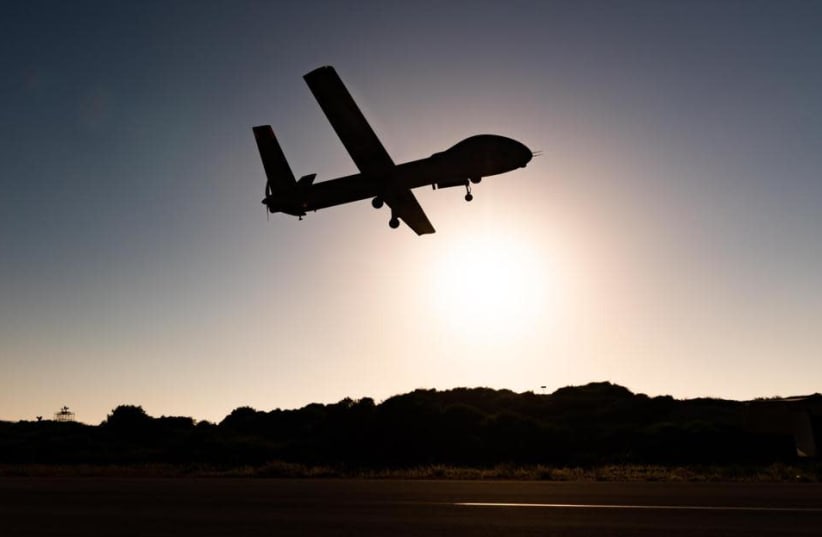Two Israeli soldiers were killed by a drone attack from Iraq. The soldiers, members of the Golani Brigade’s 13th battalion, were killed by a drone launched from Iraq on October 3. Their deaths were announced on Friday. The attack involved two drones, one of which was downed by Israel. Soldiers were also wounded in the attack.
This is one of a number of recent drone attacks against Israel. The IDF has intercepted UAVs off the coast of Israel in recent days and drone threats near Beit Shean.
The drone or unmanned aerial vehicle (UAV) threat against Israel has been growing for years. Hezbollah stockpiled an estimated 2,000 drones in its arsenal, some of them small drones such as commercially available quadcopter types, and some of them larger kamikaze drones whose technology is based on Iranian success in developing similar drones.
The Houthis in Yemen have been using drones for almost a decade. In 2020, the Iranian Shahed 136 arrived in Yemen to be used by the Houthis. This V-shaped design drone is the mainstay of Iran’s drone exports these days. It carries a warhead and has a long-range, around 2,000 miles. Iran exported it to Russia to be used against Ukraine.
In addition, Iraqi militias have acquired drones. They used the drones initially to target US forces based in the Kurdistan Region of Iraq. In January, the Iranian-backed terrorist group Kataib Hezbollah killed three US service members in a drone attack on Jordan.


Kataib Hezbollah has also threatened Saudi Arabia with drone attacks in the past. The Houthis have used drones against Saudi Arabia and threatened other Gulf states, as well as attacking ships with drones.
The Iranian-backed drone programs that proliferated in the Middle East in recent years have become increasingly deadly. The commercial oil tanker Mercer Street was struck by a drone in July 2021, killing two crew members. A drone launched from Iran’s Chabahar also struck the Pacific Zircon ship in November 2022.
Strikes on the mainland
Now, Iran and its proxies have turned their drone armies on Israel. Iran used drones in its April attack on Israel. The Houthis have targeted Israel numerous times with drones. A drone launched from Yemen killed an Israeli in Tel Aviv in July. Israel responded by striking Hodeidah in Yemen. However, this has not deterred the Houthis. They have continued to threaten Israel with drones and long-range ballistic missiles.
Hezbollah has used kamikaze drones often in eleven months of war on Israel. It is estimated that several hundred UAVs were launched by Hezbollah. They also use drones for surveillance. In August, an IDF soldier was killed in a Hezbollah drone attack. In late September, the IDF eliminated the head of Hezbollah’s drone unit.
The Iraqi militias have increased their capabilities using drone attacks on Israel. On September 25, a drone launched from Iraq impacted Eilat. On September 29, the Islamic Resistance in Iraq, an umbrella group of Iranian-backed militias, claimed they targeted Eilat with another drone attack. On September 28, they also claimed they targeted the Golan with drones.
They made similar claims on September 23 and September 25. This came as the IDF began its operation Northern Arrows in Lebanon against Hezbollah. The Iraqi militias have increased attacks in recent days.
In the latest claim by the Iraqi militias, they claimed on October 4 that they targeted an area in southern Israel. "We hit a target in the south of the occupied Palestinian territories by means of an advanced drone." The Iranian-backed groups in Iraq also told Iranian media state media that “over the past week and months, the Iraqi resistance had also targeted sensitive and important targets in Eilat, located in the south.”
In the morning of October 4, the IDF said, “Following the sirens that sounded a short while ago regarding a hostile aircraft infiltration in the area of the Beit She'an Valley, the IAF successfully intercepted a hostile aircraft that crossed into Israeli territory from the east.”
On October 3, the IDF also said that it “intercepted a UAV in southern Israel. No injuries were reported.” In addition, in the morning, the IDF said, “Two UAVs were identified crossing from Lebanon. The IAF intercepted a UAV off the coast of Nahariya, and a fallen projectile was identified in an open area. No injuries were reported. No sirens were sounded in accordance with protocol.”
In the early hours of the same morning, the Israeli military said, “the sirens that sounded in Bat Yam, two UAVs were identified. The IAF intercepted one UAV off the coast of the Dan area, and a fallen UAV was identified in an open area. No injuries were reported.”
